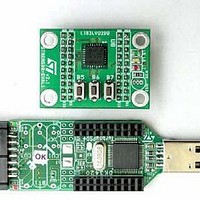STEVAL-IFS001V1 STMicroelectronics, STEVAL-IFS001V1 Datasheet - Page 18

STEVAL-IFS001V1
Manufacturer Part Number
STEVAL-IFS001V1
Description
EVAL BOARD 3AXIS MEMS ACCELLRMTR
Manufacturer
STMicroelectronics
Series
MEMSr
Datasheets
1.STEVAL-IFS001V1.pdf
(42 pages)
2.STEVAL-IFS001V1.pdf
(14 pages)
3.STEVAL-IFS001V1.pdf
(4 pages)
4.STEVAL-IFS001V1.pdf
(14 pages)
Specifications of STEVAL-IFS001V1
Design Resources
STEVAL-IFS001V1 Gerber Files STEVAL-IFS001V1 Schematic STEVAL-IFS001V1 Bill of Material
Sensor Type
Accelerometer, 3 Axis
Sensing Range
±2g, 6g
Interface
I²C, SPI
Sensitivity
1024 LSb/g
Voltage - Supply
2.16 V ~ 3.6 V
Embedded
Yes, MCU, 8-Bit
Utilized Ic / Part
LIS3LV02DQ
Processor To Be Evaluated
LIS3LV02DQ
Interface Type
USB
Lead Free Status / RoHS Status
Contains lead / RoHS non-compliant
Other names
497-5069
Available stocks
Company
Part Number
Manufacturer
Quantity
Price
5 Digital Interfaces
5.1.1
18/42
I
The transaction on the bus is started through a START (ST) signal. A START condition is
defined as a HIGH to LOW transition on the data line while the SCL line is held HIGH. After this
has been transmitted by the Master, the bus is considered busy. The next byte of data
transmitted after the start condition contains the address of the slave in the first 7 bits and the
eighth bit tells whether the Master is receiving data from the slave or transmitting data to the
slave. When an address is sent, each device in the system compares the first seven bits after a
start condition with its address. If they match, the device considers itself addressed by the
Master. The Slave ADdress (SAD) associated to the LIS3LV02DQ is 0011101b.
Data transfer with acknowledge is mandatory. The transmitter must release the SDA line during
the acknowledge pulse. The receiver must then pull the data line LOW so that it remains stable
low during the HIGH period of the acknowledge clock pulse. A receiver which has been
addressed is obliged to generate an acknowledge after each byte of data has been received.
The I
protocol must be adhered to. After the start condition (ST) a salve address is sent, once a slave
acknowledge (SAK) has been returned, a 8-bit sub-address will be transmitted: the 7 LSb
represent the actual register address while the MSB enables address auto increment. If the
MSb of the SUB field is 1, the SUB (register address) will be automatically incremented to allow
multiple data read/write.
The slave address is completed with a Read/Write bit. If the bit was ‘1’ (Read), a repeated
START (SR) condition will have to be issued after the two sub-address bytes; if the bit is ‘0’
(Write) the Master will transmit to the slave with direction unchanged.
Transfer when Master is writing one byte to slave
Transfer when Master is writing multiple bytes to slave:
Transfer when Master is receiving (reading) one byte of data from slave:
Transfer when Master is receiving (reading) multiple bytes of data from slave
Data are transmitted in byte format (DATA). Each data transfer contains 8 bits. The number of
bytes transferred per transfer is unlimited. Data is transferred with the Most Significant bit (MSb)
first. If a receiver can’t receive another complete byte of data until it has performed some other
2
Master
Master
Master
Slave
C Operation
Slave
Slave
Master
Slave
2
Master
Slave
C embedded inside the LIS3LV02DQ behaves like a slave device and the following
ST
ST
ST
ST
SAD + W
SAD + W
SAD + W
DATA
SAD + W
SAK
SAK
SAK
SUB
SUB
CD00047926
SAK
SUB
MAK
SAK
SAK
SAK
SUB
SR
SR
SAD + R
DATA
DATA
SAK
SAD + R
SAK
SAK
DATA
SAK
NMAK
DATA
DATA
DATA
SAK
LIS3LV02DQ
NMAK
SAK
SP
MAK
SP
SP
SP





















